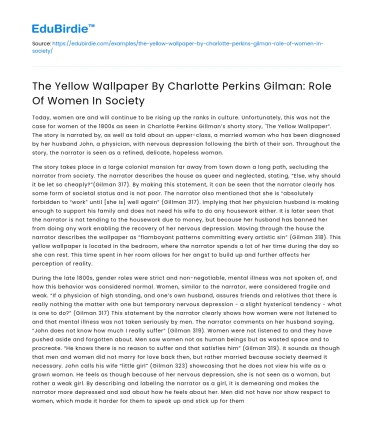Today, women are and will continue to be rising up the ranks in culture. Unfortunately, this was not the case for women of the 1800s as seen in Charlotte Perkins Gillman’s shorty story, 'The Yellow Wallpaper”. The story is narrated by, as well as told about an upper-class, a married woman who has been diagnosed by her husband John, a physician, with nervous depression following the birth of their son. Throughout the story, the narrator is seen as a refined, delicate, hopeless woman.
The story takes place in a large colonial mansion far away from town down a long path, secluding the narrator from society. The narrator describes the house as queer and neglected, stating, “Else, why should it be let so cheaply?”(Gilman 317). By making this statement, it can be seen that the narrator clearly has some form of societal status and is not poor. The narrator also mentioned that she is “absolutely forbidden to “work” until [she is] well again” (Gillman 317). Implying that her physician husband is making enough to support his family and does not need his wife to do any housework either. It is later seen that the narrator is not tending to the housework due to money, but because her husband has banned her from doing any work enabling the recovery of her nervous depression. Moving through the house the narrator describes the wallpaper as “flamboyant patterns committing every artistic sin” (Gilman 318). This yellow wallpaper is located in the bedroom, where the narrator spends a lot of her time during the day so she can rest. This time spent in her room allows for her angst to build up and further affects her perception of reality.
Save your time!
We can take care of your essay
- Proper editing and formatting
- Free revision, title page, and bibliography
- Flexible prices and money-back guarantee
During the late 1800s, gender roles were strict and non-negotiable, mental illness was not spoken of, and how this behavior was considered normal. Women, similar to the narrator, were considered fragile and weak. “If a physician of high standing, and one’s own husband, assures friends and relatives that there is really nothing the matter with one but temporary nervous depression - a slight hysterical tendency - what is one to do?” (Gilman 317) This statement by the narrator clearly shows how women were not listened to and that mental illness was not taken seriously by men. The narrator comments on her husband saying, “John does not know how much I really suffer” (Gilman 319). Women were not listened to and they have pushed aside and forgotten about. Men saw women not as human beings but as wasted space and to procreate. “He knows there is no reason to suffer and that satisfies him” (Gilman 319). It sounds as though that men and women did not marry for love back then, but rather married because society deemed it necessary. John calls his wife “little girl” (Gilman 323) showcasing that he does not view his wife as a grown woman. He feels as though because of her nervous depression, she is not seen as a woman, but rather a weak girl. By describing and labeling the narrator as a girl, it is demeaning and makes the narrator more depressed and sad about how he feels about her. Men did not have nor show respect to women, which made it harder for them to speak up and stick up for themselves.
The narrator is mistreated and enslaved by her husband John, who thinks he is curing her depression, but this makes the narrator more helpless. It is made to believe that John is very caring and madly in love with the narrator, but she believes he is more controlling. “He said that I was his darling and his comfort and all he had and that I must take care of myself for his sake, and keep well” (Gilman 323). John portrays himself as a caring and loving husband but to the extreme where it is more micromanaging. “Of course I never mention it to them - I am too wise,-but I keep watch of it all the same” (Gilman 323). This shows that the narrator is aware of how controlling her husband is and that if she were to share certain details with him there would be consequences for her. She later tried to convince John that she wanted to go back to their original home. “Whether you can see it or not. I am a doctor, dear, and I know” (Gilman 323-324). Because John is a doctor and very controlling, he continues to talk down to treat the narrator as nothing.
This short story, written by Charlotte Perkins Gilman, was partially depicted from her own life experiences. She had a lonely childhood and was not treated well by her husband when she had periods of her depression. The narrator went through similar situations as Gilman did and her stories are what made this piece. The fact that the narrator was an upper-class, married woman made already put her in a difficult situation. But add mental health to the equation, and that makes for an even more difficult life for a person.






 Stuck on your essay?
Stuck on your essay?

